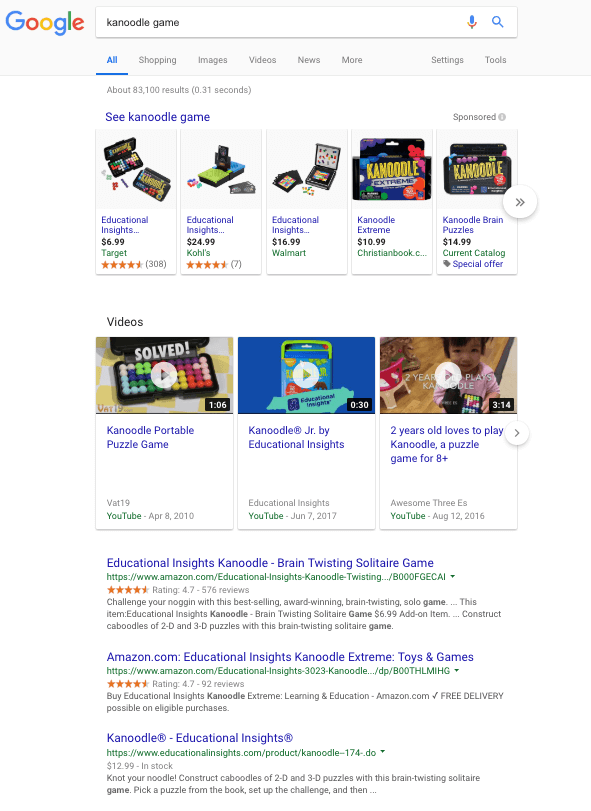
How to Rank Your Product Pages Higher in Google SERPs
For many e-commerce brands that sell their own product, showing up within the first few listings on Google can be a challenge — even if your product is a Best Seller on Amazon. If you want to improve how consumers find your products and possibly increase Direct to Consumer sales on your own e-commerce site, you’ll need to understand the layout of Google’s search engine result pages (SERPs). You’ll also need to learn how to optimize your product pages so Google ranks them higher than online retailer listings.
The anatomy of a product search engine result page
Looking at one of Amazon’s best selling games, Kanoodle, it’s easy to see how Google SERPs may make it difficult to increase Direct to Consumer sales. When you search for “Kanoodle game” in Google, you get a full page that includes a variety of listings, all of which belong to other retailers.
For any product search, you’ll see SERP sections for:
- Google Shopping
- Google Adwords
- Organic results
- Videos
In the case of the Kanoodle game, we see listings for online retailers above the fold (the visible window). Directly after the videos—and well below the fold—is a listing for the actual brand, Educational Insights, that makes and sells the game. Users have to scroll to the bottom of the page to find the company site which, according to a number of studies, decreases the click-through rate to 2%. This is a common problem for companies, especially those who sell on Amazon and other online retailers.
If you’re wanting to drive traffic to your e-commerce site, increase Direct to Consumer sales, and help your website appear higher on SERPs, there are a few things you can do.
Get your product detail page to show up higher in SERPs
“Google” your own product, preferably one that performs well. Look at what pops up: Is your company website with the product listing found above the fold? Or do you have to scroll down or even click to the next page to find your listing? Wherever your actual brand listing is, take note of it; you’ll be working to improve your Google ranking and SERP appearance in the following steps. Here’s what you need to do:
1. Set up Google Merchant Center
Google Merchant is what you need to make sure your brand’s products are showing up in Google Shopping—not just other online retailers. (Note how Educational Insights isn’t showing up in the Google Shopping section?) If you haven’t already set up Google Merchant, do so now. Google offers a very in-depth guide for its set up and use. The Merchant dashboard is also where you’ll be using Google AdWords, so take the time to set this up properly.
2. Run a branded search campaign
As we’ve seen with companies like Educational Insights, other online retailers are ranking for their product while their listings fall to the bottom. One way to fix this is to run an AdWords branded search campaign using their product and brand name. This:
- Increases brand name visibility so people connect the product with your company
- Helps drive traffic to your own website rather than online retailers
- Can improve search ranking as more people find (and click) your listing
It also makes you competitive in the AdWords location on Google SERPs. For Kanoodle, Amazon takes the ad spot for the product when Educational Insights should be showing up there, instead.
3. Add product schema to the product detail page
Schema markup is “microdata” that can be embedded into the code of your website. When Google’s crawlers scan your site, this microdata is used to better match search queries to your site.
Schema markup makes it possible to give users more information, as well as helps your products show up stronger in SERPs. With different types of markup, you can:
- Add an image to your Google search result
- Show the URL structure (breadcrumbs) of your site
- Pull reviews directly to your listing
- Show multiple products via site links
- Use product vocabulary to connect to more searches
By focusing on the right schema markup for your product and website, you’ll be better able to optimize your search listing and therefore improve rank.
4. Optimize and enrich the product detail page
Last but not least, it’s time to talk about the content on your actual product detail page. The stronger the content and optimization on your product pages, the more likely they are to show up above the fold. For Educational Insights, a little optimization could move their result from #2 to #1 in the organic search results, which would encourage Direct to Consumer sales.
Here’s what you need to keep in mind for your product detail pages:
- Title: Recommended 50-60 characters, including a strong keyword. Product name and company should also be included. Example: Kanoodle® – Educational Insights®
- Snippet (meta description): Approx. 300 characters chosen to describe the product and encourage consumers to click through. If you use keywords that match a search query, Google may show the keyword in bold to indicate the content is connected to the user’s search. Keep in mind Google’s crawlers may truncate snippets.
- URL: An easy-to-read URL that contains keywords similar to title. Redirect URLs that end in complex tails like /alj1efr3aljf53adf9ad$a6ldfalidjfl%.
Following basic SEO best practices is the best way to see your Google listing move higher in SERPs so make sure to give it some time and attention.
Track your product’s progress
Keep in mind that all of the changes you make to your product pages and ad campaigns will take time to make an impact. Google AdWords can be run over a series of days or months to increase traffic and brand recognition, and it can take a few days or weeks for Google’s crawlers to properly index a new page or page updates.
If you’re hoping to appear higher in Google SERPs or to improve your actual listing, these steps will help. Write down where and how you’re appearing in the SERPs now so you can see the progress you’ll make in the coming weeks. Also make sure to search in an incognito window when looking for your own products to avoid any biased search results.








